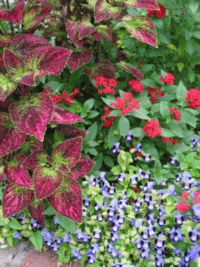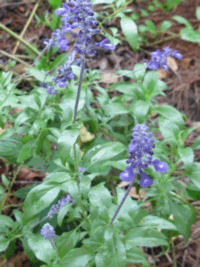
May is here! It is time for warm season plants. Before you start shopping and planting, examine your garden. Different microclimates exist. Evaluate the conditions of moisture, air and light. A wet spot suits some plants, but not others. A container will dry out faster. An area with poor air circulation fosters fungal diseases. Determine the amount of sun and shade in each area during this season. Has anything changed that altered this conditions? Has a tree grown to provide more shade or been trimmed to provide less? Has a fence or building been added or removed? Has a low spot formed that doesn’t drain well? Consider what plants are best suited for each place. Are your beds ready? Are they weed free? Do you want to use cardboard or weed mats under mulch? Have you added compost or other organic matter?
Pull up your cool season annuals or clip them off at the ground, leaving the bottom portion in the ground to decompose and enrich the soil. Do the same for any tropicals or tender perennials that had freeze damage and are not showing new growth. When selecting a color scheme, decide on shades of one color, complimentary colors or contrasting colors. Swathes of the same color make the greatest visual impact. Popular, dependable warm season annuals include gomphrena, vinca, celosia, melampodium and zinnias. Zinnia elegans are beautiful, but the newer strains of Profusion zinnias and Zahara zinnias are easier to grow. Narrow leaf zinnias (zinnia angustifolia or z. linearis) are smaller, flower profusely with a sprawling growth habit and are well suited to containers or the edge of beds. For shadier areas, use torenia and impatiens. Though the Wave series of petunias are more heat tolerant, petunias are cool season annuals and won’t make it through our summers. Pentas (the word is both the singular and plural form) is a delightful plant. This tender perennial is generally grown as an annual. The Athena series is quite small, the Nova series is quite tall, the Grafitti series has beautiful colors and the Butterfly series is the best. (That’s not only my opinion, but also that of the LSU Agricultural Center.) The LSU Agcenter designates tough and beautiful plants that perform well in Louisiana as Louisiana Super Plants. ‘Butterfly’ series pentas are a spring 2011 Louisiana Super Plant selection. I have found this series to be more likely to return after a mild freeze, to produce larger flower clusters and to be more nectar rich. It truly attracts more hummingbirds and butterflies, especially Monarchs, Gulf Fritillaries and Swallowtails. It grows in containers or beds, from sun to part shade, producing flowers in shades of white, pink red and lavender.
New F1 Hybrid Gaillardia ‘Mesa Yellow’ is very drought tolerant and bred from our native Blanket Flower Black eyed Susans (Rudbeckia), purple coneflowers (Echinacea purpera) and blanket flower (Gaillardia) are wonderful wildflowers that are available in several cultivars and varieties for the garden. I have recently found Gaillardia F1 ‘Mesa Yellow’ available in local garden centers. This is the first hybrid blanket flower with a controlled growth habit and prolific flowering. It is an All American Selection Winner (AAS) that performs well here. Salvia is a genus of many perennial, annual and biennial species from temperate, subtropical and tropical zones. They are attractive to hummingbirds, bees and skippers (small butterflies). Which ones are easy to find and easy to grow? Salvia ‘Indigo Spires’ , S. leucantha (Mexican bush sage), S. coccinea (cultivars include Lady in Red and Coral Nymph), S. greggii and S. farinacea (mealy cup sage) are all available in nurseries and garden centers. They are also easy to propagate from cuttings and some re-seed readily in the garden providing plenty of “volunteers,” so you may be able to acquire salvias from a gardening friend or share your own with others.

Wildflowers and salvias, once established, can be very drought tolerant though watering is an issue for other plants in your garden ort of irrigation system to provide thorough, deep moisture for the rest of the garden. Insufficient watering damages plants and causes shallow root systems. When is the best time to water? Watering in the morning hydrates plants for the heat of the day and is less likey to let dampness accumulate, which causes fungal diseases. Water applied later in the day evaporates too fast. I water in the evening, because that is when I have the time to do so, but avoid wetting the foliage of the plants late in the day when it won;t have a chance to dry off before night-time. Many fungi can only innoculate on wet surfaces, so leaving plants or lawns wet overnight increases the possibility of fungal disease. Mulching is an important part of helping your garden through summer-time. Mulch regulates the speed by which water reaches the roots and evaporates from the soil. It also moderates soil temperature and reduces weeds. A good two to three inch layer of mulch is recommended for all planting Many herbs are great additions to the garden and can be successful through the warmer months. Dill, Parsley and Cilantro are all starting to bolt and make seed as our weather gets warmer, but herbs such as oregano, rosemary and society garlic grow well in this area year round. Basil and Cuban oregano (not a true oregano) florish in the warm weather. Go ahead and harvest herbs that do not do well in heat, like garden sage and parsley or let them re-seed in your garden for next year. Is it too hot to cook with your herbs? Use your culinary herbs in a mayonnaise base for tuna, chicken or potato salad. Plant a beverage garden with stevia for sweetening and mint, lemon balm or pineapple sage (Salvia elegans) for flavoring tea or other drinks. Always plant extra fennel, dill and parsley in your herb garden as a host plant for Eastern Black Swallowtails. Though these plants will bolt quickly in summer heat, caterpillars do feed on these plants while they last. If you don’t want to share, cover them with netting. Celebrate May with your warm weather garden!
submitted by Kathy McCrocklin
